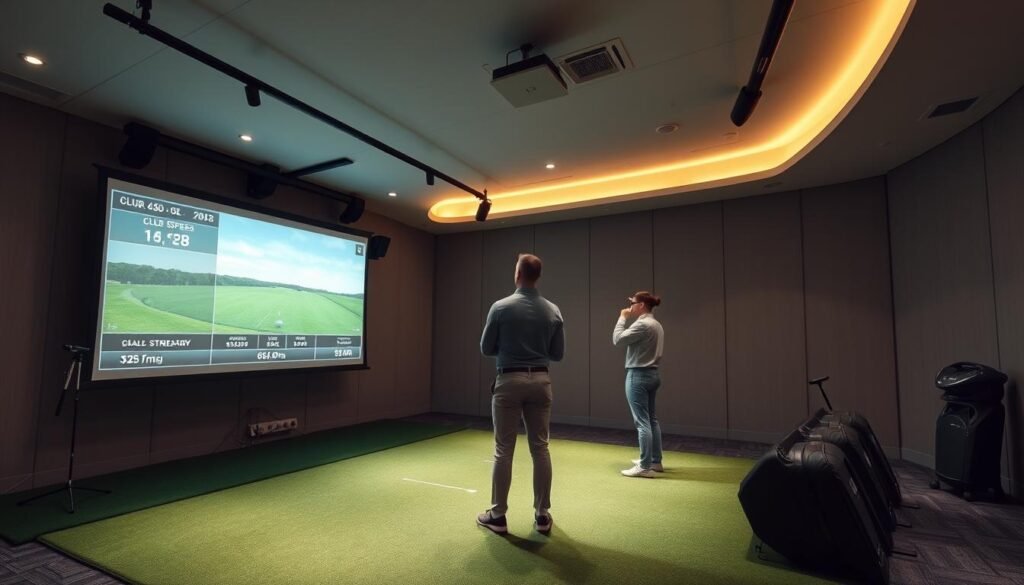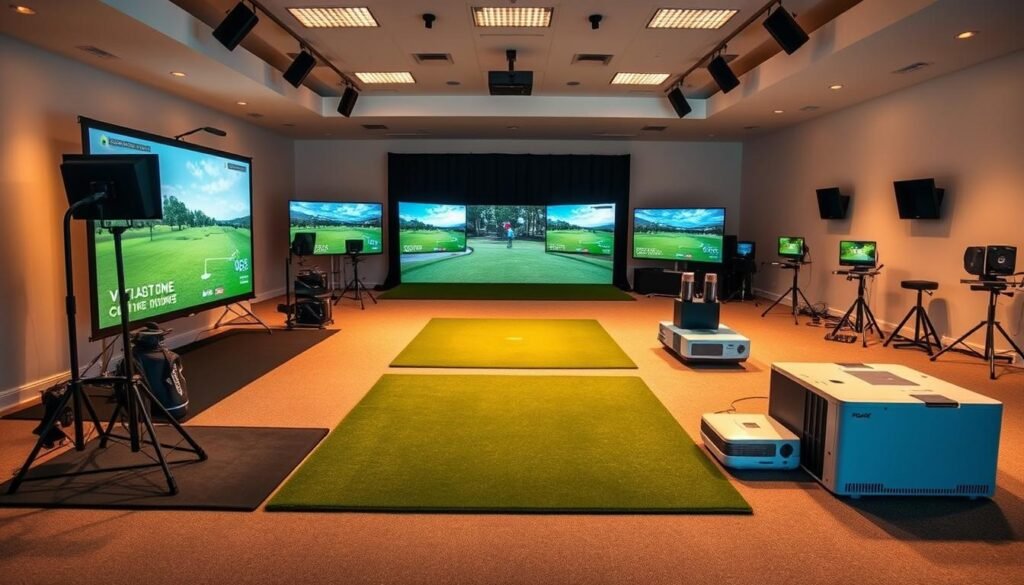Imagine mastering your swing without battling crowded courses or unpredictable weather. Modern golf simulator technology offers beginners an innovative way to build skills from home. But does this investment truly help newcomers improve faster—or is it just a pricey gadget?
These systems analyze every detail of your shot, from club speed to ball trajectory. You’ll get instant data that even seasoned players rarely access during casual rounds. No need to chase stray balls or wait for fairways to clear—just focused practice.
Indoor setups eliminate seasonal limitations, letting you train year-round. For those hesitant about on-course pressure, home golf environments provide a judgment-free zone to experiment. Advanced metrics highlight flaws in your grip, stance, or follow-through that might go unnoticed outdoors.
While the upfront cost matters, consider long-term savings on range fees and travel. Smaller spaces can still accommodate compact systems, making indoor golf feasible for apartments and garages. The real question: Does this tech match your commitment level?
Key Takeaways
- Practice in a stress-free environment without time constraints or audience pressure
- Receive instant feedback on swing mechanics and ball flight patterns
- Evaluate space requirements and budget before purchasing equipment
- Accelerate skill development with professional-grade performance analytics
- Maintain consistency through weatherproof, year-round training sessions
Understanding the Advantages of Golf Simulators for New Golfers
Modern training tools transform how players refine their technique. Unlike traditional methods, these systems turn every swing into a learning opportunity through precise measurements and accessible data visualization.

Instant Feedback and Data-Driven Insights
Advanced sensors track your club movement and ball behavior in real time. Metrics like backspin rotation and face angle at impact appear instantly, helping you connect physical actions to flight patterns. This eliminates guesswork when adjusting grip pressure or stance width.
| Factors | Indoor Simulator | Outdoor Range |
|---|---|---|
| Feedback Type | 17+ Data Points | Visual Estimation |
| Weather Impact | None | High |
| Time Efficiency | Immediate Analysis | Delayed Review |
Convenience and Year-Round Practice Opportunities
Home setups remove common barriers to consistent training. Rainy afternoons or freezing mornings won’t interrupt your routine. Fifteen-minute sessions between daily tasks become viable, helping build muscle memory faster.
Space constraints? Compact simulator packages fit in single-car garages or spare rooms. You’ll save hours previously spent commuting to courses while accessing virtual replicas of famous fairways.
Also read: Golf Simulator: The Ultimate Beginner’s Guide
Are Golf Simulators Worth for Beginners
How do you determine if tech-driven practice aligns with your needs? Start by analyzing your dedication to improvement versus casual play. Entry-level systems demand serious financial planning—a basic setup runs $5,000, while premium configurations exceed $20,000.
Evaluating Your Golfing Goals and Investment
Calculate your break-even point. At $61 per round, 82 practice sessions equal a $5,000 system’s cost. Frequent users recoup expenses faster through saved green fees and travel time. Ask yourself: Will this tool serve daily drills or occasional entertainment?
Long-term value matters. High-end systems retain resale potential, but tech evolves rapidly. Budget for software updates and potential hardware repairs. Compact spaces work for swing analysis, though course management skills develop better outdoors.
Deciding Between Simulated Play and Real-Course Experience
Indoor training sharpens mechanics through instant feedback on launch angles and spin rates. However, wind reading and uneven lies require actual fairway time. Balance both methods—use the simulator for repetition and real greens for situational strategy.
Your available space and technical comfort affect success. Garage setups need 10-foot ceilings and proper lighting. If tinkering with sensors feels daunting, consider professional installation costs. Match the system’s complexity to your commitment level.
Budget vs. High-End Golf Simulator Options
Entry-level and premium systems cater to different priorities in training and investment. Your choice hinges on how deeply you want to analyze your game versus simply enjoying practice sessions. Let’s break down what each tier offers.

Key Features of Budget Simulators
Starter packages between $2,000 and $5,000 deliver core functionality without overwhelming complexity. These systems focus on essential metrics like ball speed and swing path using straightforward launch monitors. Many arrive pre-configured for DIY assembly—no technical expertise required.
Upgrade paths let you enhance components later. Swap basic nets for impact screens or add software expansions as your skills progress. This flexibility makes budget options ideal for testing your commitment before diving into pricier setups.
Advantages of High-End, Luxury Setups
Premium configurations exceeding $10,000 replicate pro-level training environments. Millimeter-perfect tracking analyzes clubface rotation and spin axis tilt with surgical precision. You’ll practice on photorealistic versions of Pebble Beach or St. Andrews through 4K projection systems.
Advanced software packages include multi-angle swing playback and skill challenges. Some even let you play virtual baseball or soccer. While costly, these systems grow with you for decades through regular firmware updates.
| Factor | Budget | High-End |
|---|---|---|
| Tracking Precision | ±2% Margin | ±0.5% Margin |
| Course Variety | 15-20 Virtual | 100+ Licensed |
| Space Needs | 8’x10′ Minimum | 12’x15′ Ideal |
Exploring Essential Components and Simulator Setup
Building your practice space starts with three non-negotiable elements working in harmony. These tools transform spare rooms into professional-grade training zones while protecting your walls from rogue shots.
Launch Monitors, Impact Screens, and Projectors
Your launch monitor acts as the system’s brain. Entry-level models like SkyTrak measure ball speed and launch angle, while premium versions track clubface rotation. Pair it with a durable impact screen—Carl’s Premium model withstands 15,000 strikes when hung with equal tension.
Projectors bring virtual courses to life. The Optoma GT2000HDR delivers bright 4K visuals even in daylight. Measure your room’s dimensions first—short-throw models work best in tight spaces.
DIY Enclosures and Home Golf Environment Tips
Metal frame kits from brands like Carl’s let you build custom enclosures. Leave 18 inches between the screen and wall for safety. Use acoustic panels to dampen noise if neighbors complain about late-night practice.
Don’t forget supporting gear:
- Graphics cards (NVIDIA RTX 3060 or better) for smooth software performance
- Fairway Series mats that mimic rough and fairway textures
- LED lighting positioned to avoid sensor glare
Test different ball types—avoid marked or dirty ones that degrade impact screens. Ventilation matters too; install fans to prevent overheating during marathon sessions.
Benefits of Indoor Golf Simulators for Beginners
Mastering the basics becomes effortless when training in distraction-free environments. These systems transform repetitive drills into engaging skill-building sessions through smart design and adaptive technology.
Developing Solid Golf Fundamentals
Your grip alignment and weight distribution get microscopic attention during indoor golf sessions. Instant replays show how rotating your wrists 3 degrees affects ball flight—details invisible during live play. Practice mats with texture variations help ingrain proper turf interaction habits.
Structured challenges make technical work rewarding. Target-based games measure progress in putting consistency or fairway accuracy. You’ll fix slice tendencies faster through 20-minute focused drills than weeks of sporadic range visits.
Practice Modes and Course Variety
Switch between skill-building modes with a tap. Driving range simulations let you crush 300 balls without judgment, while virtual rounds at Pinehurst teach strategic club selection. Replay controversial shots from four angles to spot stance errors or rushed transitions.
| Practice Type | Key Benefit | Real-Course Transfer |
|---|---|---|
| Virtual Course Play | Strategic Thinking | Hazard Avoidance |
| Shot Replay | Mechanical Analysis | Swing Consistency |
| Skill Games | Precision Training | Short Game Mastery |
Rain or shine, your progress continues uninterrupted. Winter months become prime time for refining wedge distances rather than waiting for spring thaw. The system’s shot history tracks incremental improvements that motivate consistent practice.
Also read: Are Golf Lessons on a Simulator Worth It?
Practical Considerations and Cost Comparisons
Crunching the numbers reveals why many opt for home setups. With average course fees climbing yearly, a one-time purchase could unlock decades of affordable practice.
Green Fee Savings and Long-Term Investment
Four weekly virtual rounds save $12,688 annually compared to real-course play. A $5,000 system pays for itself in 83 sessions—less than five months for dedicated players.
| Expense Type | First Year | 5-Year Total |
|---|---|---|
| Course Fees | $12,688 | $63,440 |
| Home Setup | $6,800* | $9,200 |
*Includes hardware, software, and initial accessories
Hidden Costs and Enhancing Simulator Longevity
Budget beyond the sticker price. These often-overlooked factors impact your experience:
- High-performance PCs ($800+) for lag-free graphics
- Annual mat replacements ($150-$300)
- Climate control in garages or basements
Protect your gear with simple habits. Rotate hitting surfaces monthly and inspect balls for nicks. Impact screens last longer when cleaned with microfiber cloths after each session.
Smart maintenance stretches your investment. Track component lifespans:
- Mats: 50,000+ strikes
- Screens: 15,000 impacts
- Sensors: 7-10 years
Also read: Are Golf Lessons on a Simulator Worth It?
Conclusion
Transforming spare rooms into high-tech training zones, modern systems redefine skill development for new players. A personal golf simulator lets you analyze every swing while building confidence through repeatable drills. The convenience of home golf setups eliminates weather delays and crowded driving ranges.
Your investment depends on how deeply you want to engage with data. Budget-friendly golf simulator packages offer core metrics for casual practice, while premium systems deliver pro-level analytics. Match your choice to both space constraints and long-term improvement goals.
Seasoned golfers often blend virtual training with real-course play for balanced growth. Compact systems now fit apartments, letting you refine techniques between daily tasks. With proper setup and maintenance, these tools become lifelong allies in mastering the sport’s nuances.
Ultimately, golf simulators succeed when aligned with consistent practice habits. They won’t replace wind reading or bunker escapes—but for building muscle memory and swing mechanics, few solutions rival their precision and accessibility.